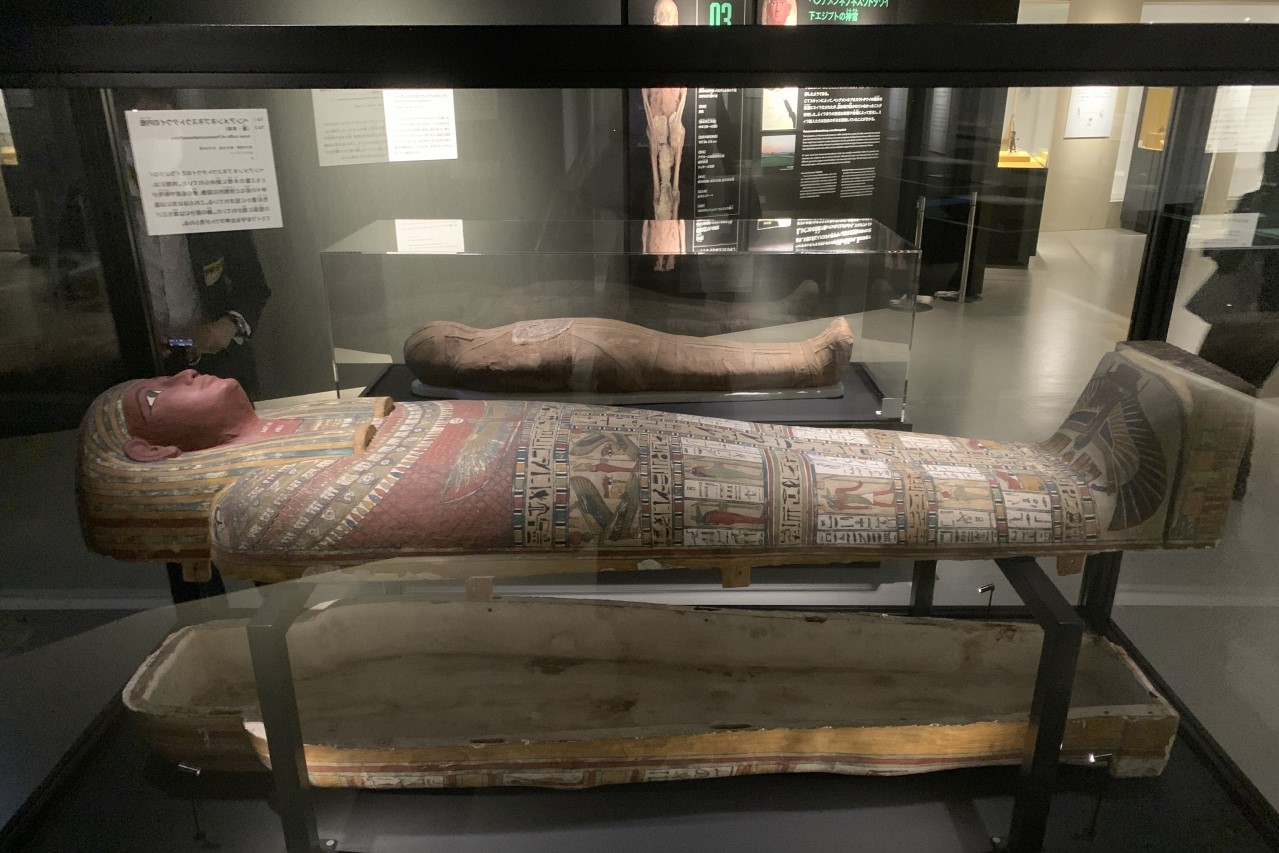Tokyo Metropolitan Art Museum
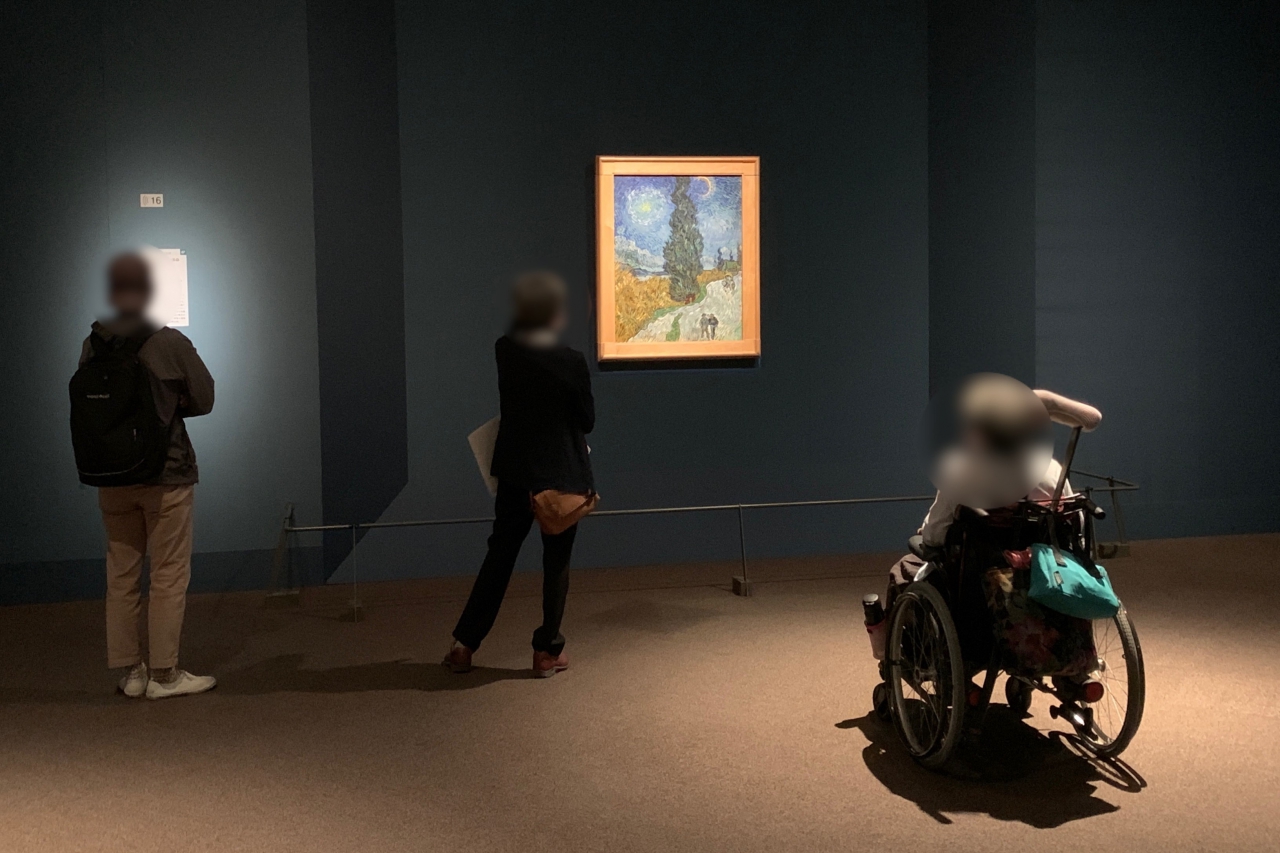
At the Tokyo Metropolitan Art Museum in Ueno Park, Tokyo, “Van Gogh Exhibition: Resonating Souls Helene and Fincent” is being held from Saturday, September 18, 2021.
The museum’s special exhibitions (most recently, “Hiroshi Yoshida Exhibition 70 Years After Death” and “Isamu Noguchi’s Discovery Road”), which introduce domestic and foreign masterpieces, are very popular every time, but this “Van Gogh Exhibition” ] Is crowded with many visitors as usual.
We want people in wheelchairs and people with various disabilities such as visual and hearing disabilities to appreciate the special exhibition with peace of mind. With that in mind, every time during the special exhibition, “people with disabilities” A special appreciation event for wheelchairs is being held, and the “Van Gogh Exhibition” was also held on October 11th (Monday), which is a closed day.
* A separate article details the venue and exhibited works of “Van Gogh Exhibition: Resonating Souls Helene and Fincent”. ⇒ https://www.culture.city.taito.lg.jp/ja/reports/22665
Art communicators who support “special appreciation for people with disabilities”

The “Special Appreciation Party for Persons with Disabilities” (hereinafter referred to as “Special Appreciation Party”) is a program that started in 1999. Since 2012, an art communicator (nicknamed “Tobira”), who is active in the “Tobira Project” in collaboration with the museum, Tokyo University of the Arts, and citizens, has been involved from the preparatory stage, helping with the day’s appreciation and speaking out. I am doing.
What is the “Door Project”?
A social design project based in a museum that nurtures a community through art. It was started in collaboration with Tokyo University of the Arts with the renewal of the Tokyo Metropolitan Art Museum in 2012. Citizens gathered from the general public, curators, university faculty members, and experts who are active on the front lines are based in the museum, and while making the best use of the cultural resources there, people and works, people and people, people and places We are developing activities to connect.
Who is the publicly recruited citizen through art as the art communicator “Tobira” (nicknamed “Tomi” and “Opening a new door” at the Tokyo Metropolitan Art Museum)? We are working on designing a place where people can have a flat dialogue and a community that connects people with diverse values.
About 40 people from Tobira, who are active for a three-year term, are recruited every year, and currently about 140 people of different ages and backgrounds, such as office workers, freelancers, housewives, retired people, and college students, are active. It seems that it has been done.
The activity is voluntary, but not a supporter given a role by the museum. He is an active player who proactively launches and realizes projects at museum sites while deepening his learning as an art communicator during his term. Until now, “Tobikan Yakan Kaikan Tour” where you can enjoy the charm of the architecture of the Tokyo Metropolitan Art Museum at night, and “Graduation Exhibition Tour” where you can talk with the artist about the graduation exhibition of Tokyo University of the Arts. Various programs utilizing the museum were carried out from a unique perspective.
The “special appreciation party” is also evolving into a better form while incorporating the ideas of “Tobira”. This time around 100 people, including “Tobira” and former “Tobira” who are active as independent art communicators in their respective communities after their term of office, welcomed the participants.
(* Hereafter, the situation on the day will be collectively referred to as “art communicator” because “Tobira” and former “Tobira” are involved in the “special appreciation party” as a whole.)
Time for people with disabilities to face the work without hesitation

About 400 people with disabilities and about 320 caregivers who have disability certificates, etc. participated in the “special appreciation event”.
The art communicators seemed to have been preparing for the “special appreciation party” many days before the event. For example, there are three types of pre-registration methods for the “Special Appreciation Party”: WEB form, email, and postcard. The participation certificate envelope sent by mail to those who applied for the postcard has the theme of the exhibition as a motif. I heard that he is pushing a handmade eraser stamp.
This is also an initiative devised by an art communicator with the desire to “make it a nice participation certificate.” I showed you the real thing, but it was a waste of quality to be used only here.


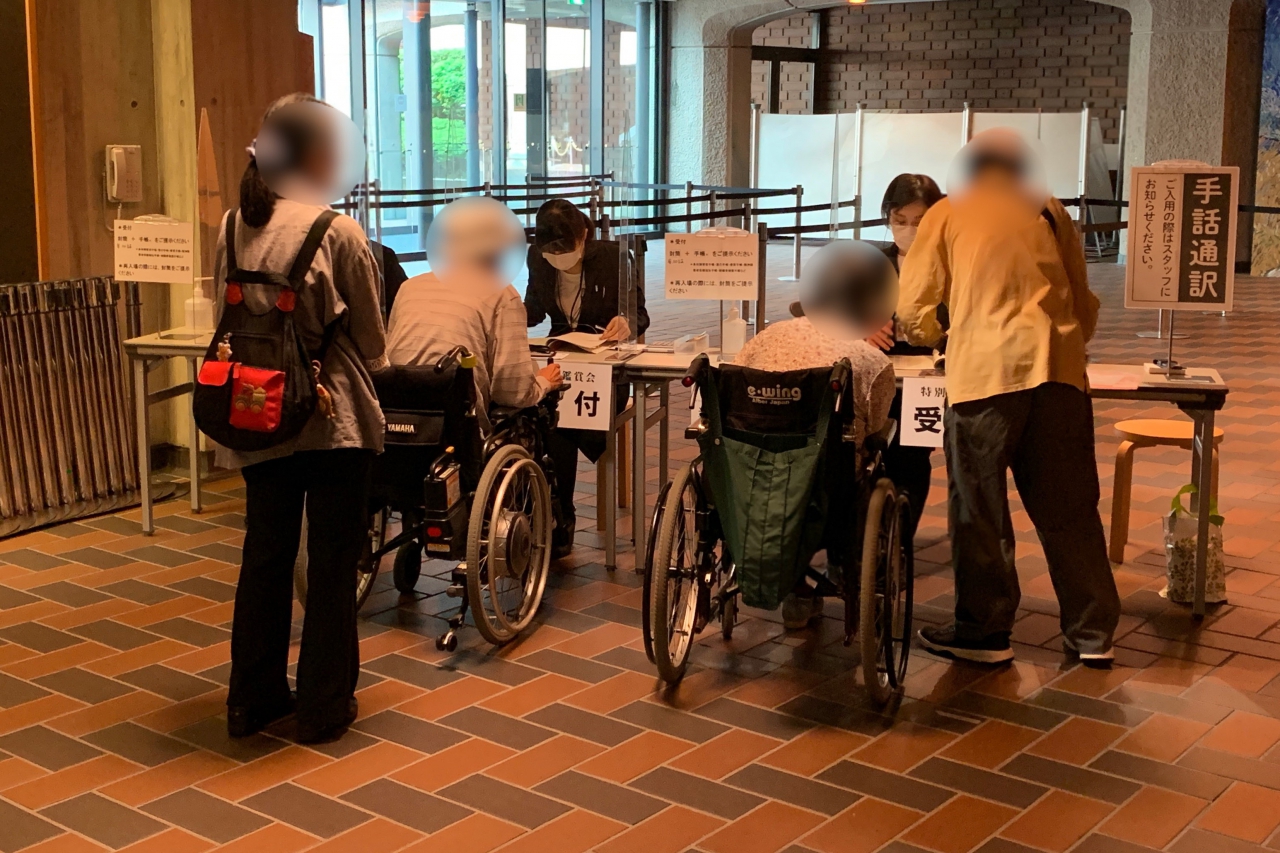
From the entrance to the reception, you will hear greetings to the participants such as “Hello” and “Please enjoy”.
Mr. Kumagai, a curator, said, “Is it okay to go? Maybe it will cause trouble?”
“It is important to create a welcome atmosphere that conveys the feeling of hospitality to the participants so that they will feel that the museum is a place where they can go.”

Wheelchairs for rent were prepared at the reception. I was wondering, “Isn’t the person who needs a wheelchair riding from the beginning?”, But there are many people with bad legs who want to use a wheelchair only when looking at the exhibition. I was surprised to see that a large number of wheelchairs were actually rented out in a blink of an eye.
As Mr. Kumagai said, such people may find it difficult to go to the usual exhibitions in consideration of their surroundings. Of course, it seems that wheelchairs are rented even on normal opening days, but if they are prepared in front of the entrance of the exhibition room like this, everyone seems to be comfortable and easy to use.
Here, I felt that I could get a glimpse of the reason why the repeat rate of the “special appreciation party” was so high.
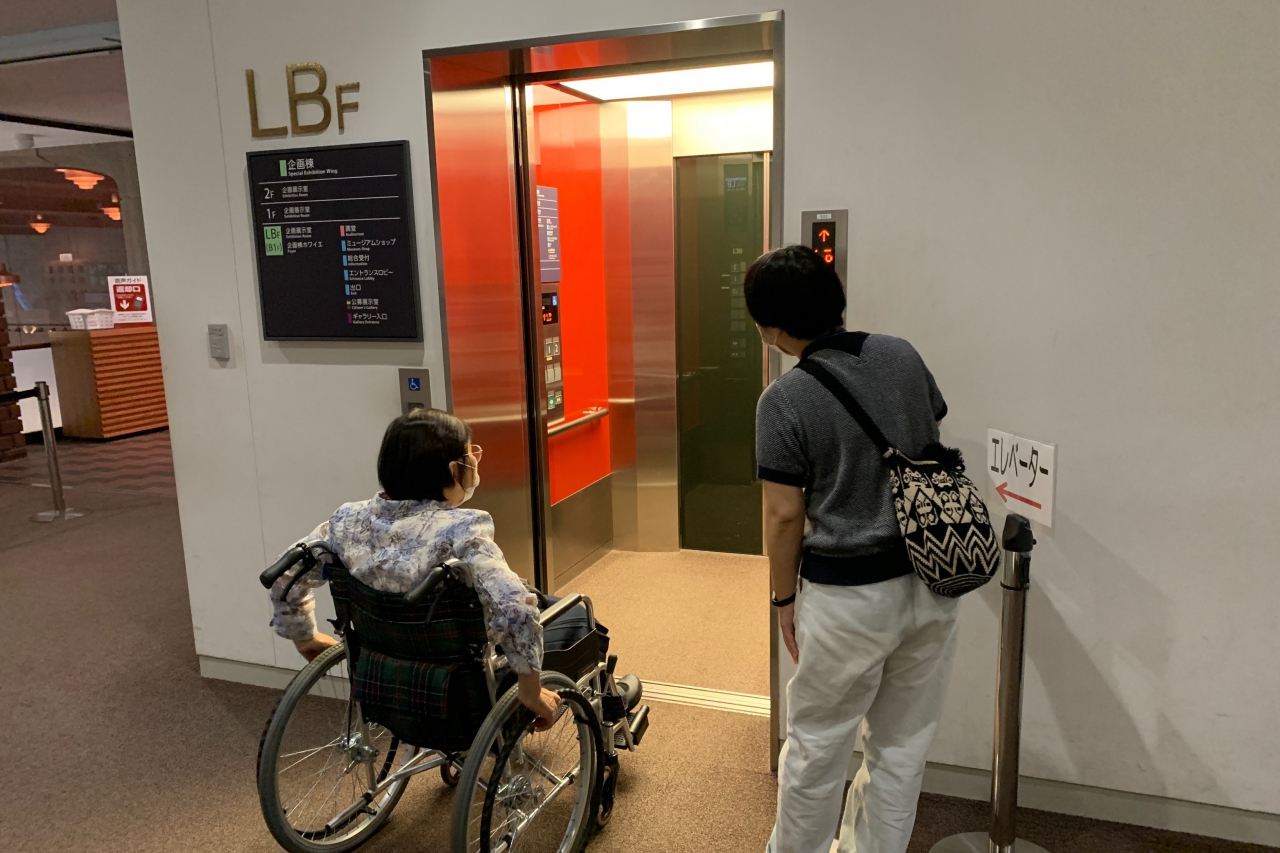

Not only the exhibition room of the special exhibition, but also the entrance, escalators, elevators, etc., the art communicators will entertain you almost everywhere the participants pass. We kept in touch with each other in each position and saw them working closely together.
An unfamiliar sight is that a large elevator for luggage was in operation.
If many people in wheelchairs try to use the normal elevator for visitors at the same timing, the waiting time will inevitably occur. With the desire to enjoy the “special appreciation party” without stress, the art communicators at the site made suggestions for improvement, such as “If there are multiple wheelchairs, we will guide you to a large elevator.” It is impressive that we were discussing.
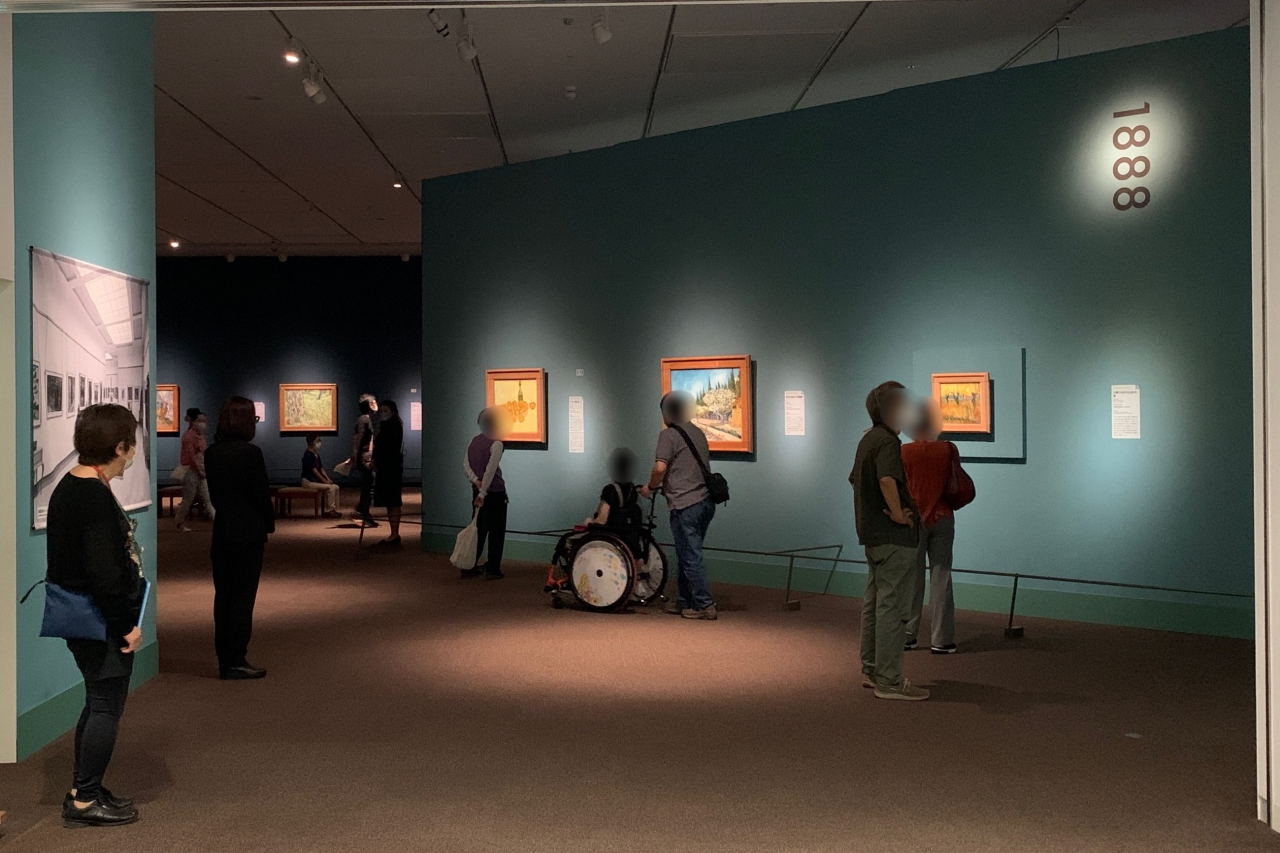
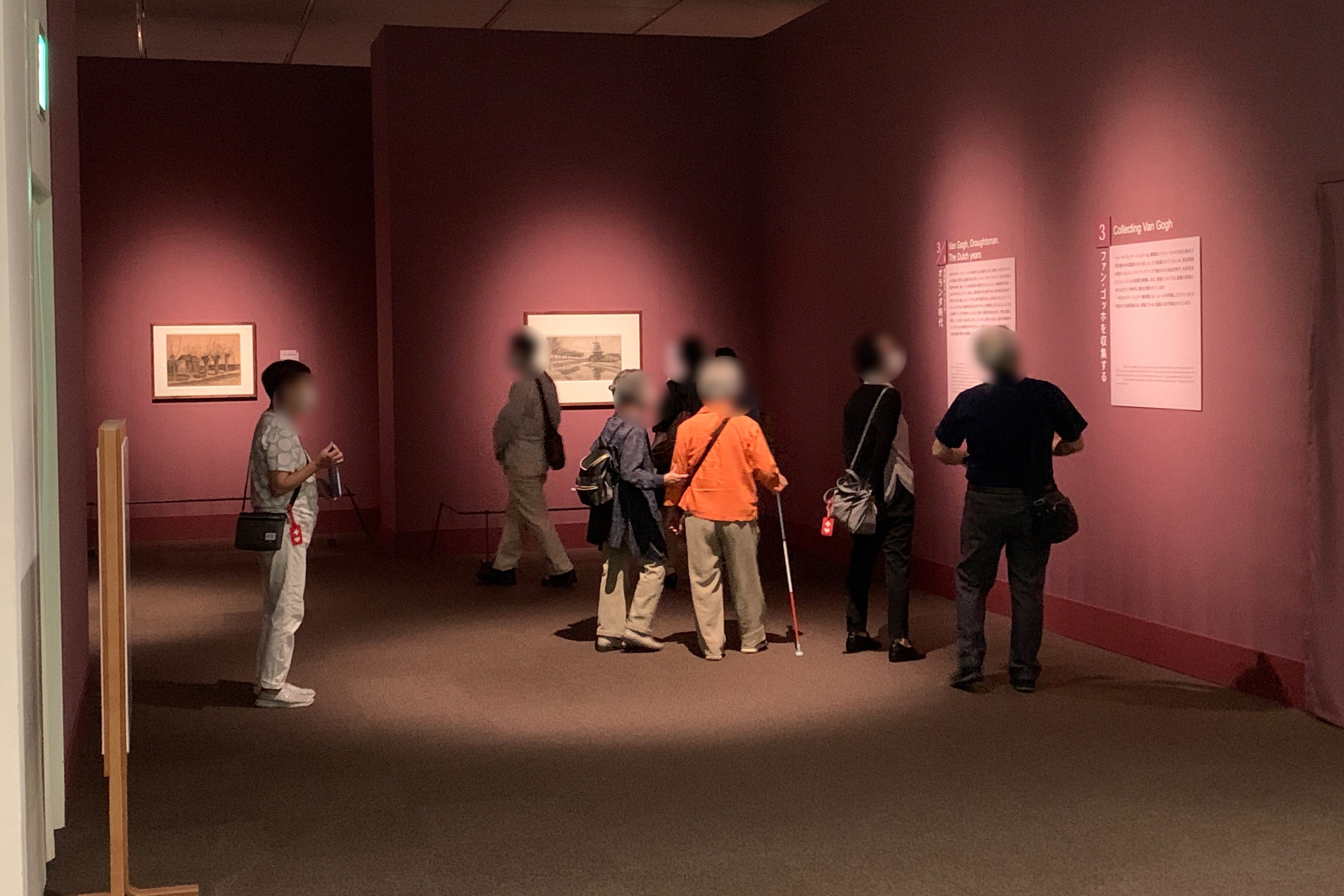
Since it is a viewing party that requires advance reservations, a very relaxing time will flow in the exhibition room. It seemed that all the participants were able to appreciate the work.

This is also in front of the main feature of this exhibition, “Country Road in Provence at Night”. At the time of normal opening, the front of popular works is often crowded, and wheelchair users tend to watch from behind. I could see that he was enjoying the time of one-on-one dialogue.
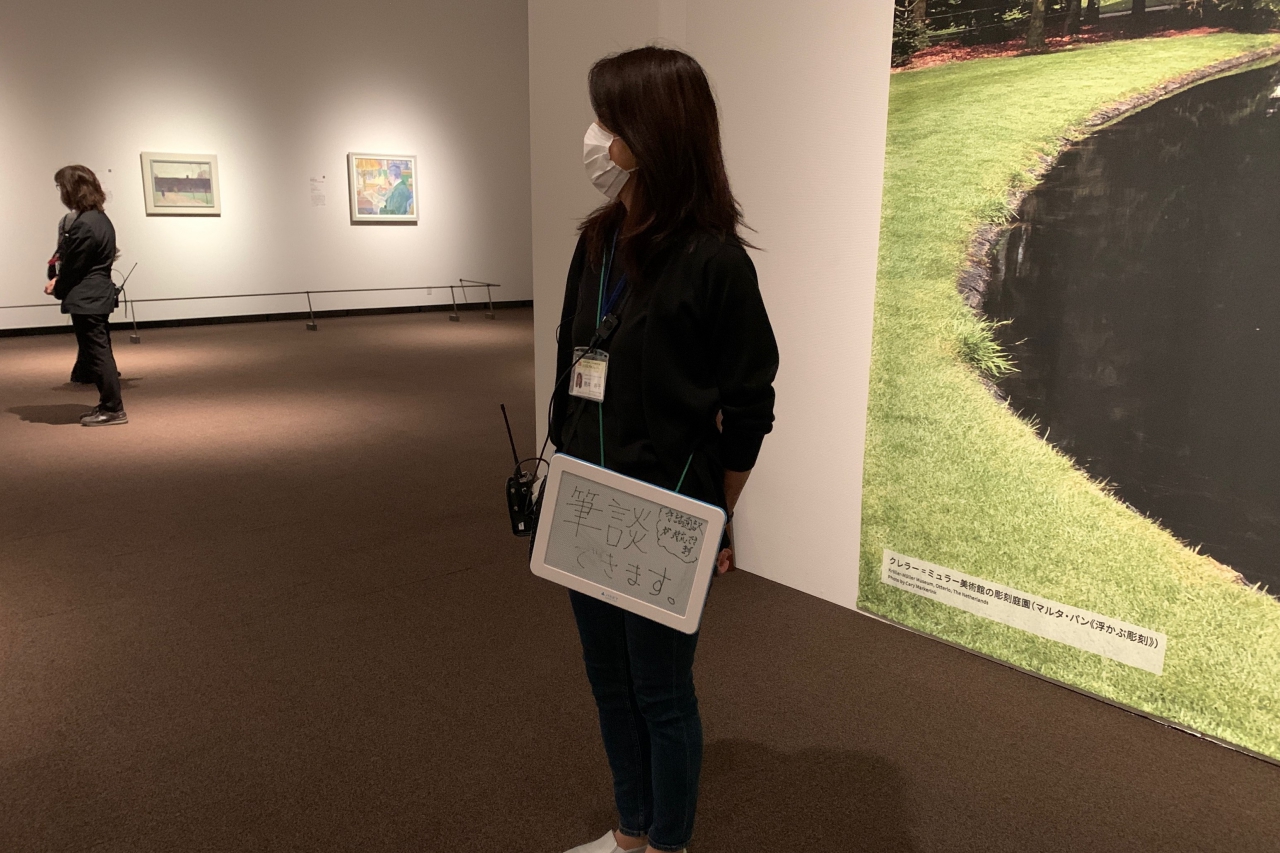
In the exhibition room, there is also an art communicator carrying a magnetic writing board for the hearing impaired. This is an initiative that started from this “special appreciation event” and is an attempt to create an environment where people with hearing impairments can easily talk to them when they have a problem in the exhibition room. While talking using the written conversation board, it is possible to have a sign language interpreter called from the reception if necessary.
I couldn’t see it at the time of the interview, but before the epidemic of the new coronavirus infection, the participants and the art communicator exchanged their impressions and opinions while watching the work, and each of them shared a good time.
Based on the idea of an art communicator, those who have difficulty seeing the work, such as those with low vision or wheelchairs, can see the work image at hand. He also carried out activities such as creating character display support so that the content can be conveyed to people with hearing impairments in the “One Point Talk” that explains the highlights of the meeting.

When asked about these various initiatives, Mr. Kumagai emphasized, “Art communicators are creating a community through art based in museums.” I will do something for people with disabilities. I am not in the place of this “special appreciation party” in the relationship between the supporter and the recipient. “
“What kind of place do you want to be in this space where people with and without disabilities spend time together? What kind of place do you want to be? Think about it, and communicate and act as necessary for that. Therefore, art communication There is no manual that summarizes what to do in Ta, “he said, which is often misunderstood as an art communicator.
Unfortunately, many efforts to avoid contact and closeness are not feasible nowadays. But it became painful feelings in the expression of the Art communicator lament the “I’m in great pains same space, is lonely not able to talk with everyone of the participants”, communication and way not to conversation, and even more real He is looking for a way to complement the dialogue outside of the space .
“Special appreciation party” under such circumstances. Participants who enjoyed Van Gogh’s world to their heart’s content for an hour or two left the museum with a very satisfying expression.
“I’m always looking forward to the next appreciation party.”

We also talked to the people who participated in the “special appreciation party”. What surprised me was that everyone I talked to had participated in the “special appreciation party” many times.
A woman in a wheelchair said, “This appreciation party is helpful because the number of people is limited. Normally, people are double, triple, or quadruple, but here you can see it in the forefront. I’m happy, “he smiled.
Another participant, who said he had been away from the museum he had visited because of his illness, said, “I’m always looking forward to the next event.” He shines his eyes and talks about his expectations.
A visually impaired woman participated at the timing when she read Maha Harada’s novel and was eager to see Van Gogh’s work, and she seemed to be happy. It seems that he watched the work while having a caregiving explain it.
“I think the audio guide was well done. I understood that Mr. Helene (* the collector of Van Gogh’s work featured in this exhibition) was such a person,” he said with satisfaction. While following the changes in his style, he was deeply moved, saying, “This is how Van Gogh arrived at <Sunflower>.”
“In an ordinary exhibition, even if a caregiving person walks with me, I get hit or kicked. On the contrary, even if I interrupt in front of a person, I feel sorry because I do not notice it. I’m grateful that you can see it with confidence if it’s so vacant. ”
Originally, the museum should be an open place for people with and without disabilities. Unfortunately, many people now hesitate to go to museums.
There may be more ingenuity in the “special appreciation event for people with disabilities”. However, I realized that the existence of such an appreciation party is a significant attempt to surely lower the hurdles for people with disabilities to go to the museum.
We will continue to pay attention to the movements of art communicators on how to create communication opportunities that have diminished in the Corona disaster.
In addition, in the special exhibition “Vermeer and 17th Century Dutch Painting Exhibition in the Dresden National Classical Painting Museum” to be held from January 22nd (Sat) to April 3rd (Sun), 2022 at the Tokyo Metropolitan Art Museum, “Obstacles” “Special viewing party for those who have” will be held.
400 people and their caregivers (up to 1 person) who have various notebooks such as the certificate of the physically disabled can apply. If there are many applications, it will be a lottery.
The application period is from January 5, 2022 (Wednesday) to January 24, 2022 (Monday).
If you are interested, please check the details. ⇒ https://www.tobikan.jp/learn/accessprogram.html
“Van Gogh Exhibition — Resonating Souls Helene and Vincent” Outline
| Session | September 18th (Sat) -December 12th (Sun), 2021 |
| venue | Tokyo Metropolitan Art Museum Planning Exhibition Room |
| Opening hours | 9: 30-17: 30 Fridays 9: 30-20: 00 (Admission is 30 minutes before closing) |
| Closed days | Monday * However, the room will be open on November 8th (Monday), November 22nd (Monday), and November 29th (Monday). |
| Admission fee | General 2,000 yen, university / vocational school students 1,300 yen, 65 years old and over 1,200 yen * Reservation required by date and time. * Free for high school students and younger. (Reservation with specified date and time is required) Click here for other details ⇒ https://gogh-2021.jp/ticket.html |
| Organizer | Tokyo Metropolitan Foundation for History and Culture Tokyo Metropolitan Museum of Art, Tokyo Shimbun, TBS |
| inquiry | 050-5541-8600 (Hello dial) |
| Exhibition official website | https://gogh-2021.jp |
National Science Museum

Known as a cultural heritage hall of fame, the British Museum has led the world in the study of ancient Egyptian civilization. A special exhibition “British Museum Mummy Exhibition: Six Ancient Egyptian Stories” will be held at the National Museum of Nature and Science in Ueno, Tokyo, focusing on the six mummies carefully selected by the museum, based on the latest research results. It is being held.
* The session is from October 14, 2021 (Thursday) to January 12, 2022 (Wednesday).
We covered the press preview held on the day of the opening, so we will report on the situation at the venue.
* The photos shown are taken with special permission, and the general public is prohibited from taking them.
* The photo is often reflected on the glass due to the equipment. Please note that some parts may be difficult to see.
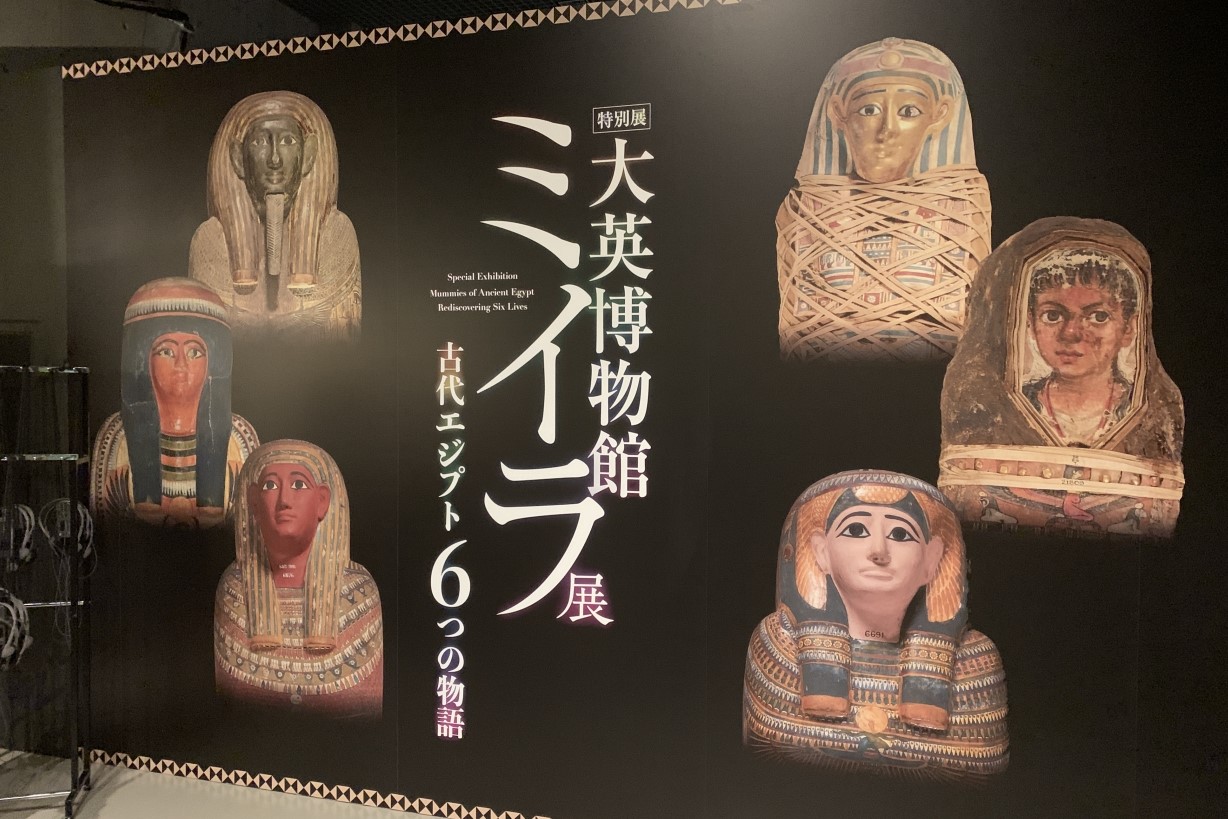
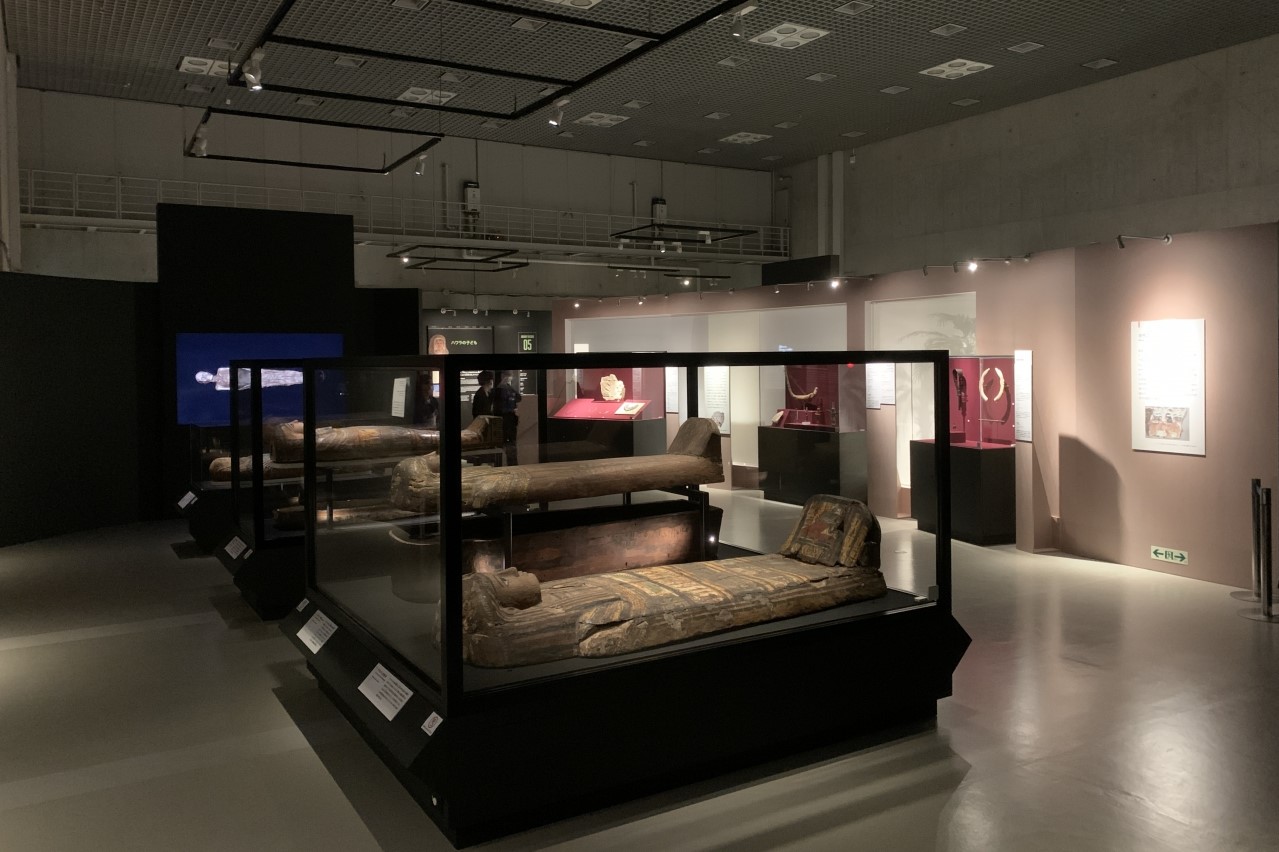
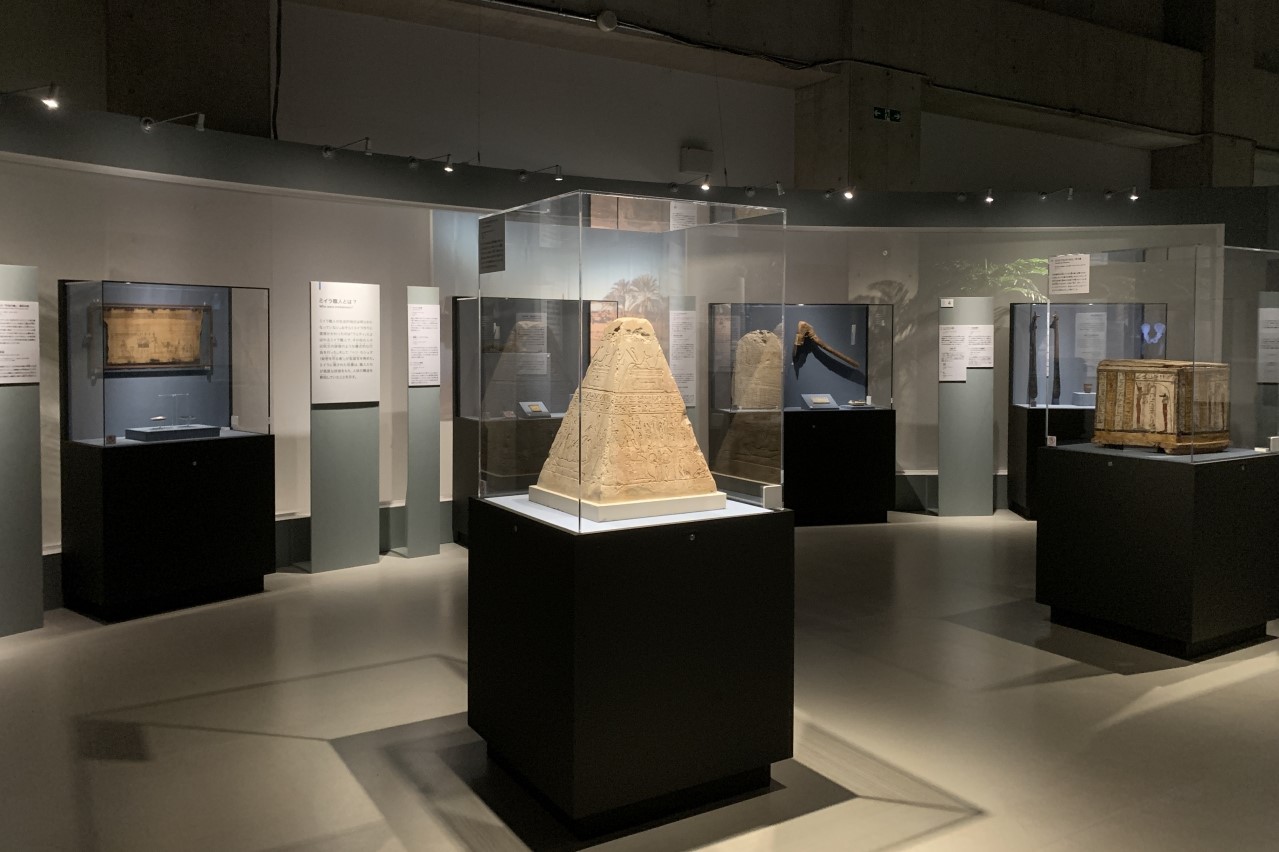
An ancient Egyptian figure unraveling from six mummies
Even if they die in this world, their existence does not end, and the ancient Egyptians, who had the view of life and death that they would be resurrected in the afterlife, developed the technique of making mummies in order to preserve the body necessary for regeneration. In the special exhibition “British Museum Mummy Exhibition: Six Stories of Ancient Egypt”, the mummies of six people who lived in ancient Egypt from about 800 BC to about 100 BC are exhibited.
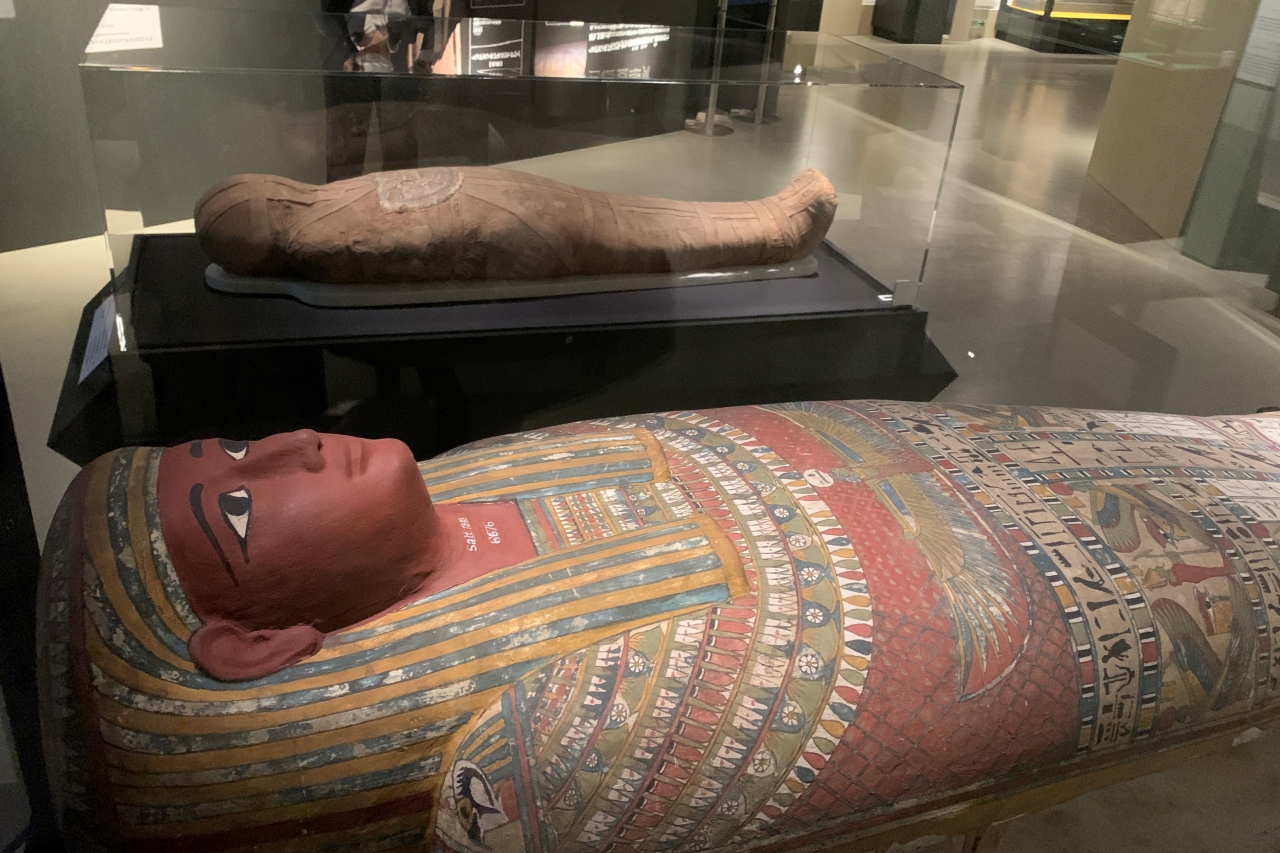
The bright decoration of the casket is eye-catching. On the chest is the image of the god Nut, who spreads his wings as if to protect him.
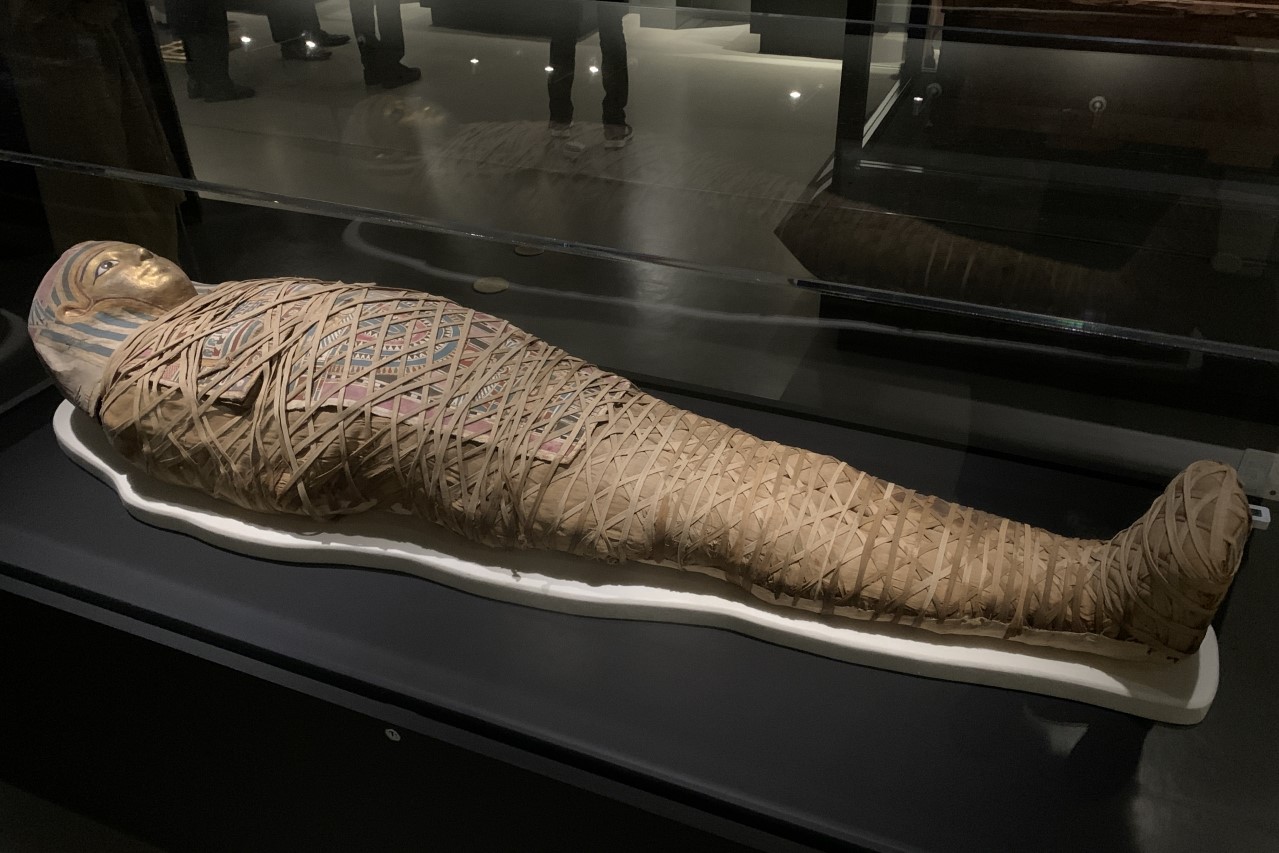
“Amen Iri Ireto Thebes officials” “Nesper Ennebu Thebes priests” “Pen Amen Nebnes Uttaui lower Egyptian priests” “Takenemet Thebes married women” “Hawara children” “Young men of the Greco-Roman era” Six mummies with different positions, ages, and times of life.
The interior is restored with a high-precision 3D construction image created based on a large amount of CT scan images of about 7,000 images per body. Introducing life aspects such as health condition, medical history such as cancer and arteriosclerosis, and age of death that could not be understood from textual information such as inscriptions, along with about 250 abundant exhibits.
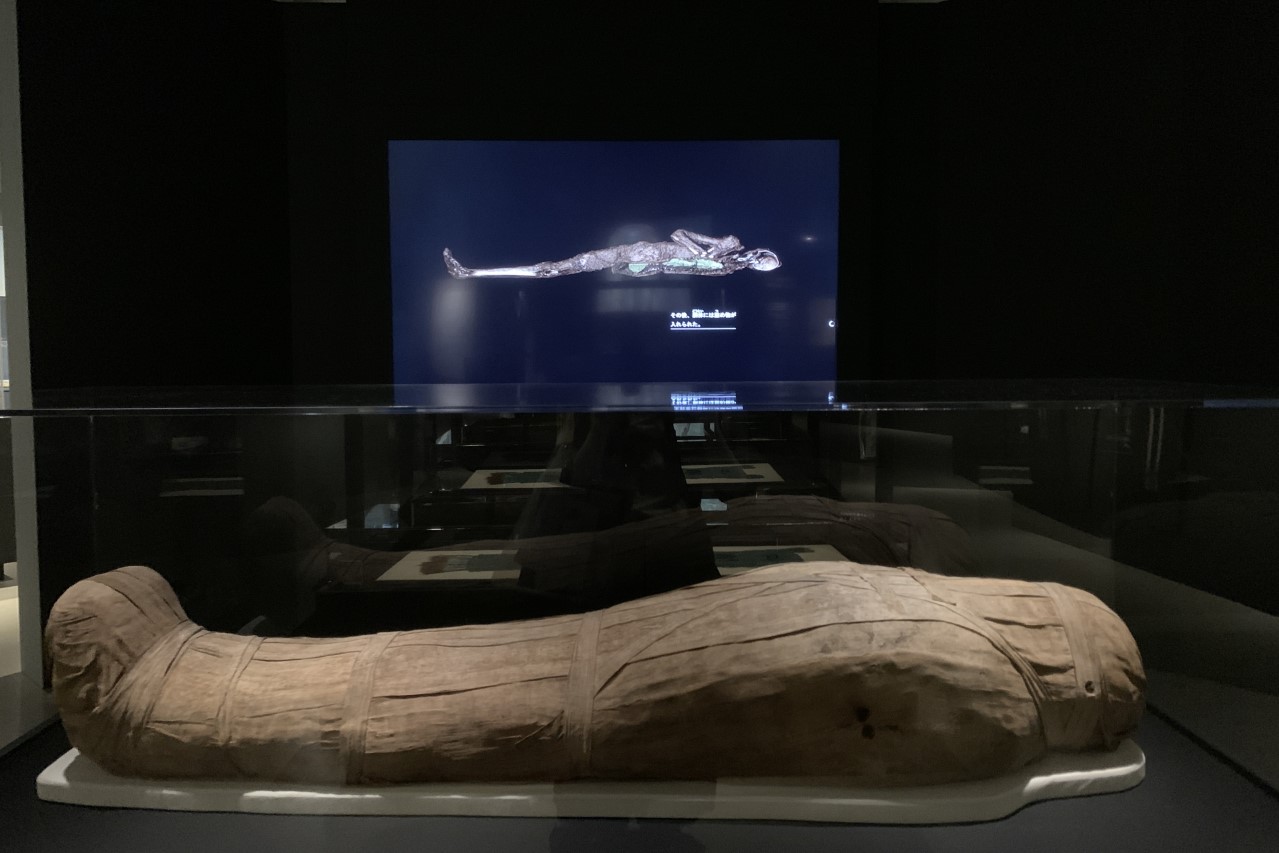
In the 3D construction video, detailed information on the inside is explained, as well as the clarified medical conditions during life.
Of particular interest to the benefit of CT scans is the priest of the Karnak Temple, Nesperennebuu, which was the most important religious facility in Thebes (now Luxor) around 800 BC in the Third Intermediate Period, around 800 BC. It’s a mummy.
Various amulets and magical trinkets are placed on the mummy to protect the dead and help them gain eternal life. A CT scan revealed that the Nesper Ennebu mummies remained unopened, and their detailed layout and materials were revealed.
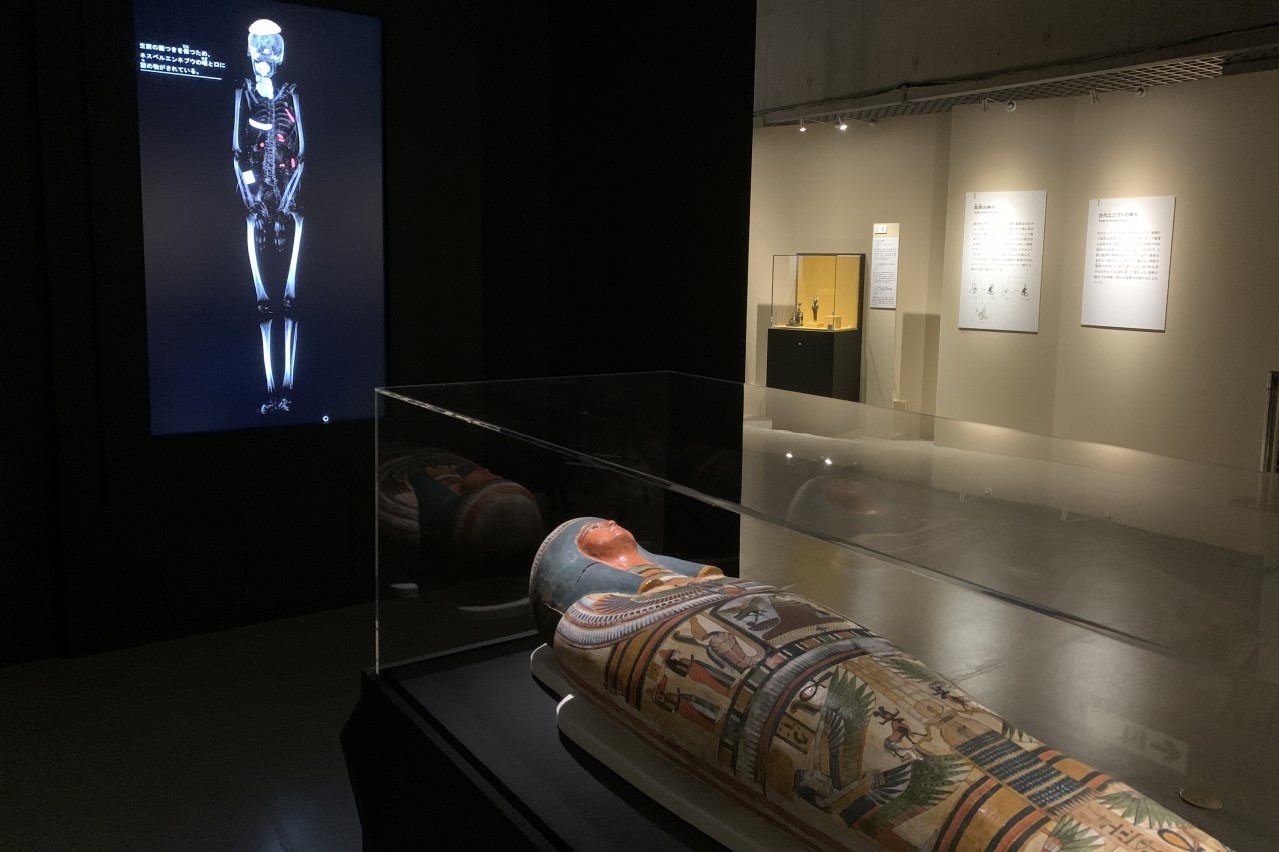
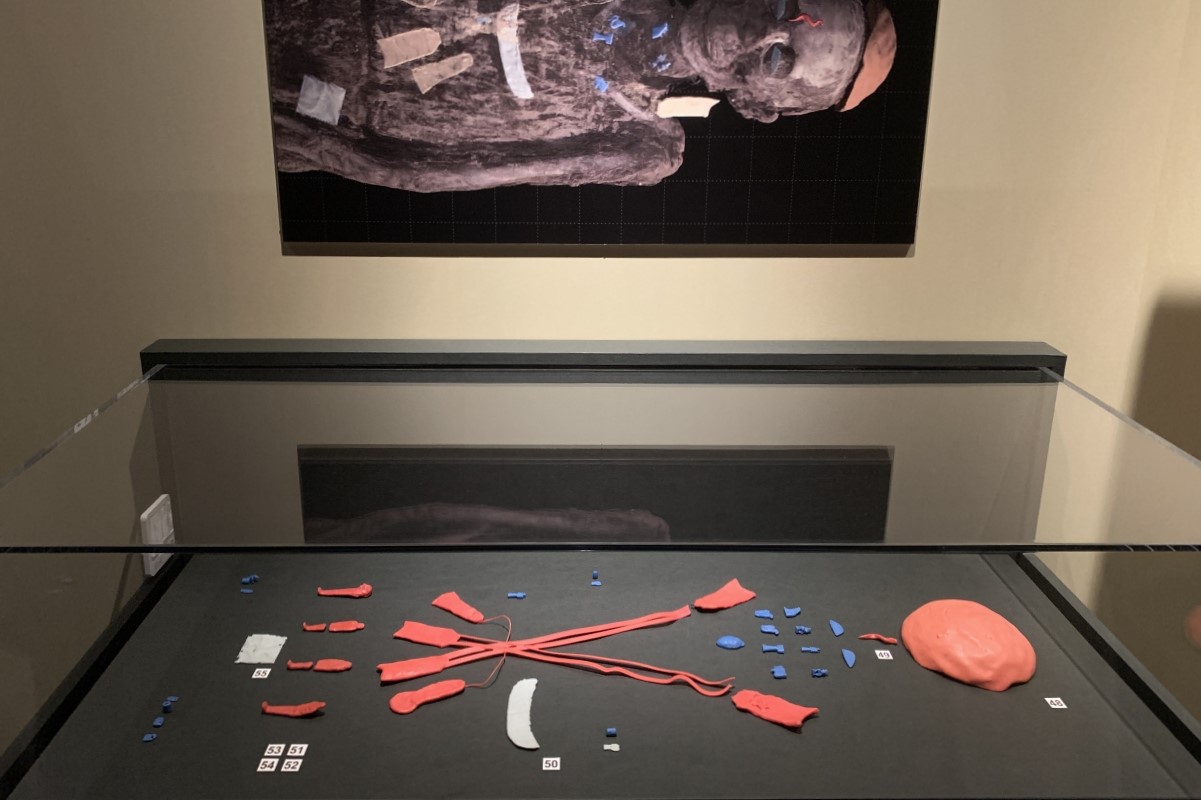
The video shows the location of the amulets and jewelry placed on the mummy, but I was surprised that they were placed not only on the skin and between the bandages, but also inside the body. It is said that amulets and accessories have important meaning not only in shape and letters but also in position, and it is a result of technological improvement that such inside information is known without damaging the relics.
Many of the items inside are 3D printed and displayed, so please compare them with the images and appreciate them.

Many relics showing the ancient Egyptian beliefs related to funerals, including mummification, are exhibited in this exhibition, but an example that clearly shows the form of one belief is the “Canopic jar”.
The perishable internal organs are removed when making mummies, but the liver, lungs, stomach, and intestines are considered to be particularly important for regeneration, and they are carefully protected by a container called the Canopic jar, which is modeled after the four sons of Horus. rice field.
Imagine that the brain is also stored somewhere on the premise of resurrection, but it seems that the brain was abandoned in the process of making a mummy because its function was not understood at that time. so…….
It is the heart that the ancient Egyptians believed to be the part that governs intelligence and memory. It is usually left in the body by a mummy craftsman as an indispensable item for regeneration.
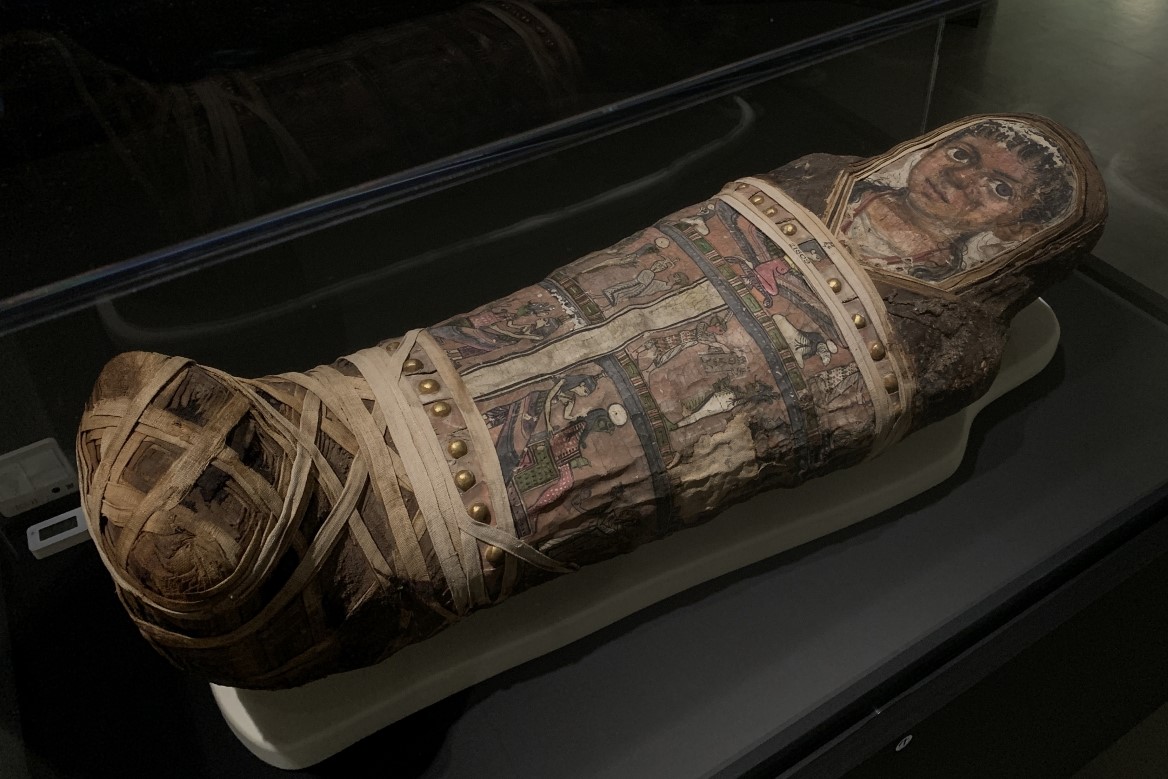
We are also paying attention to the changes in the design of mummies from time to time.
A photorealistic portrait of a child’s mummy, which was drawn to cover his head, appeared in the mummy of a child from 40 to 55 years after the Roman rule. You can feel the influence of Greek and Roman art styles. In addition, it seems that mummification of children was rare until the time of Roman rule, and it was said that the tradition of burial customs was also affected.
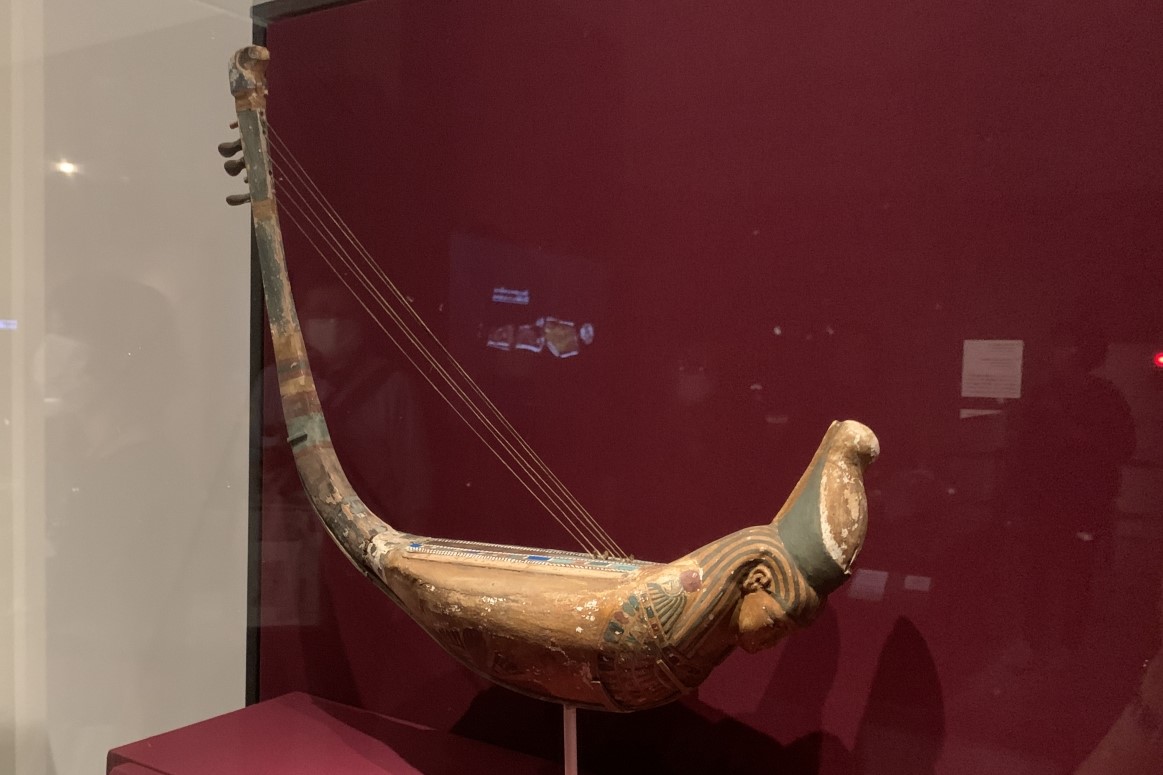
Speaking of mummies, you can also appreciate familiar relics such as the statue of Osiris, the god of the underworld who has the power of regeneration, and the document “Book of the Dead” buried with the dead in the hope of the well-being of the afterlife. In addition, this exhibition features items that are close to the culture and daily life of ancient Egyptians, such as musical instruments, women’s makeup tools, children’s toys and accessories, and fossil bread, which are rarely seen in other exhibitions. The point is also the highlight.
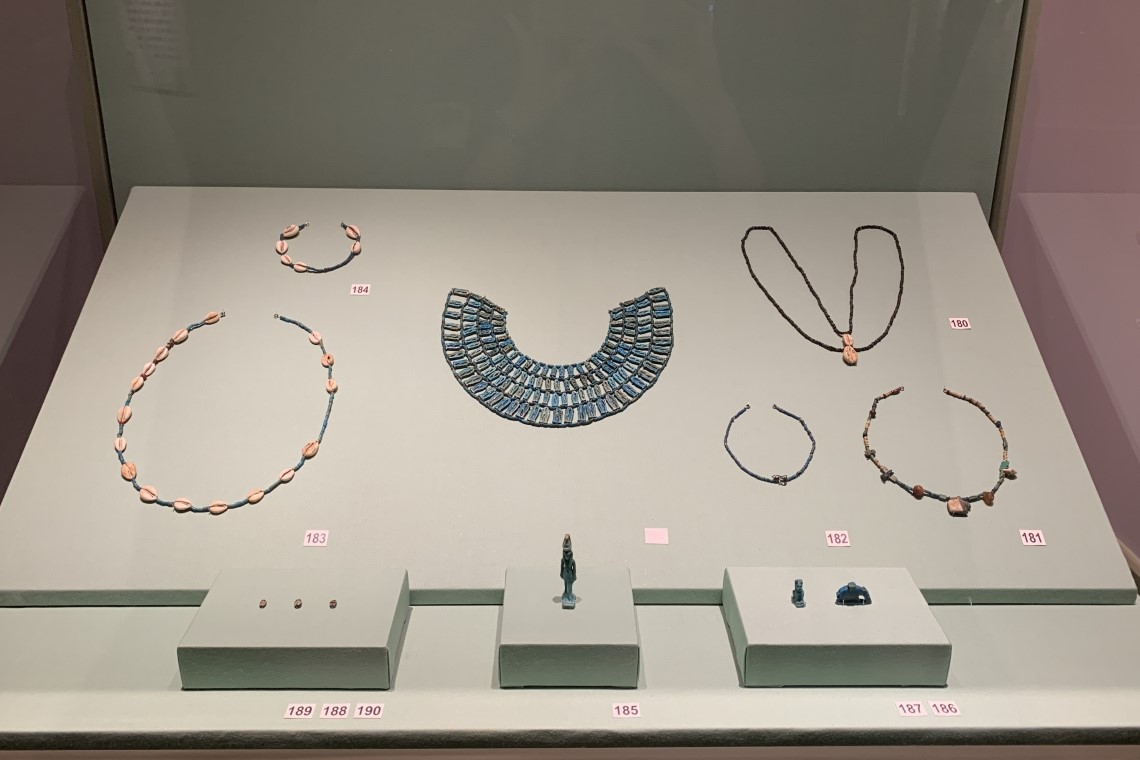
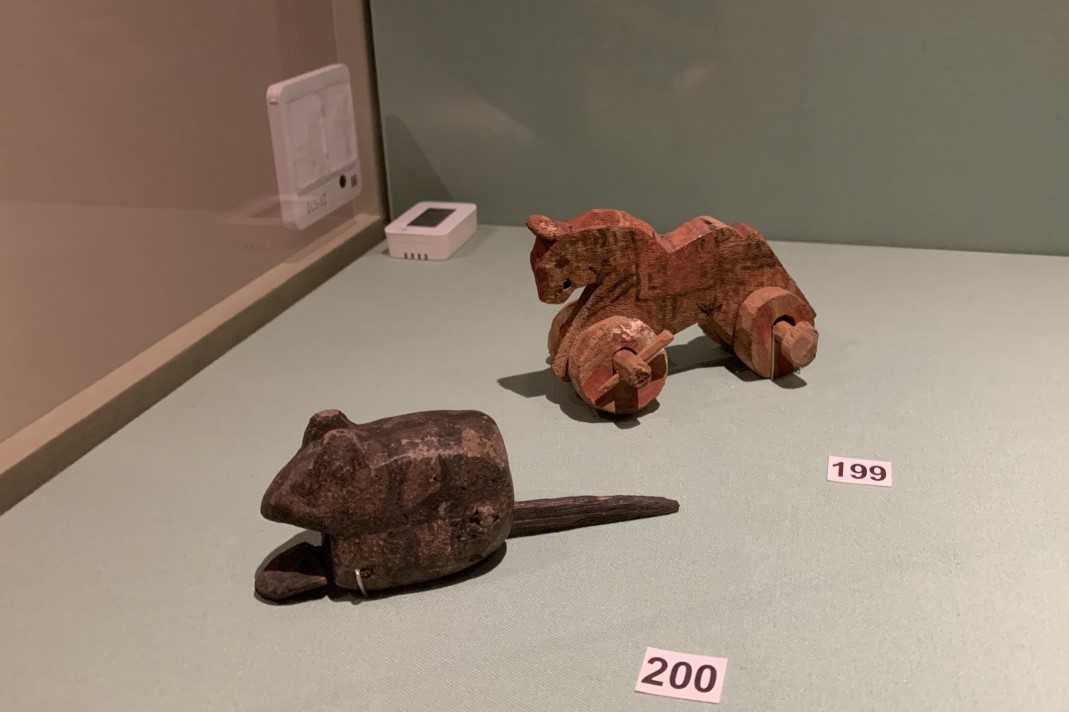
How did they live and become mummified? While feeling mysterious from the view of life and death and magical relics, it seems to be familiar to somewhere. It can be said that this is a unique exhibition where you can see the life of ancient Egyptians.
Cute things you can meet at the venue
The charm of the ancient Egyptian world is that it is full of unique and adorable designs that attract Japanese people today, such as Egyptian gods such as Medjed, Anubis, and Bastet, and hieroglyphs.
Of course, you can meet them in this exhibition, so I will introduce some photos.

Anubis, the god of mummy making, is a lovely accessory with a figure lying down on the grave. Goods were also made at the special shop at the venue!

Amulet with a fish motif that symbolizes regeneration, with beautiful gold and blue feldspar. A stylish item with large dorsal fins and tail fins.
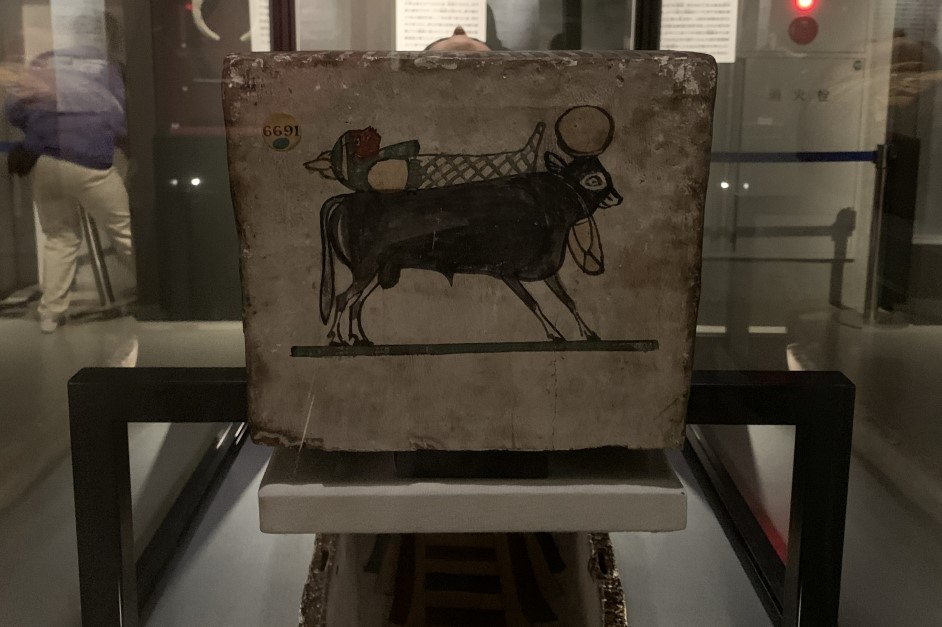
The creature (cow?) Drawn at the foot of “Takenemet’s inner casket”. Is the round head a corner? Or is it like a ball? I can’t say anything about the blurred expression.
Japan original exhibition: Archaeological excavation of Saqqara ruins
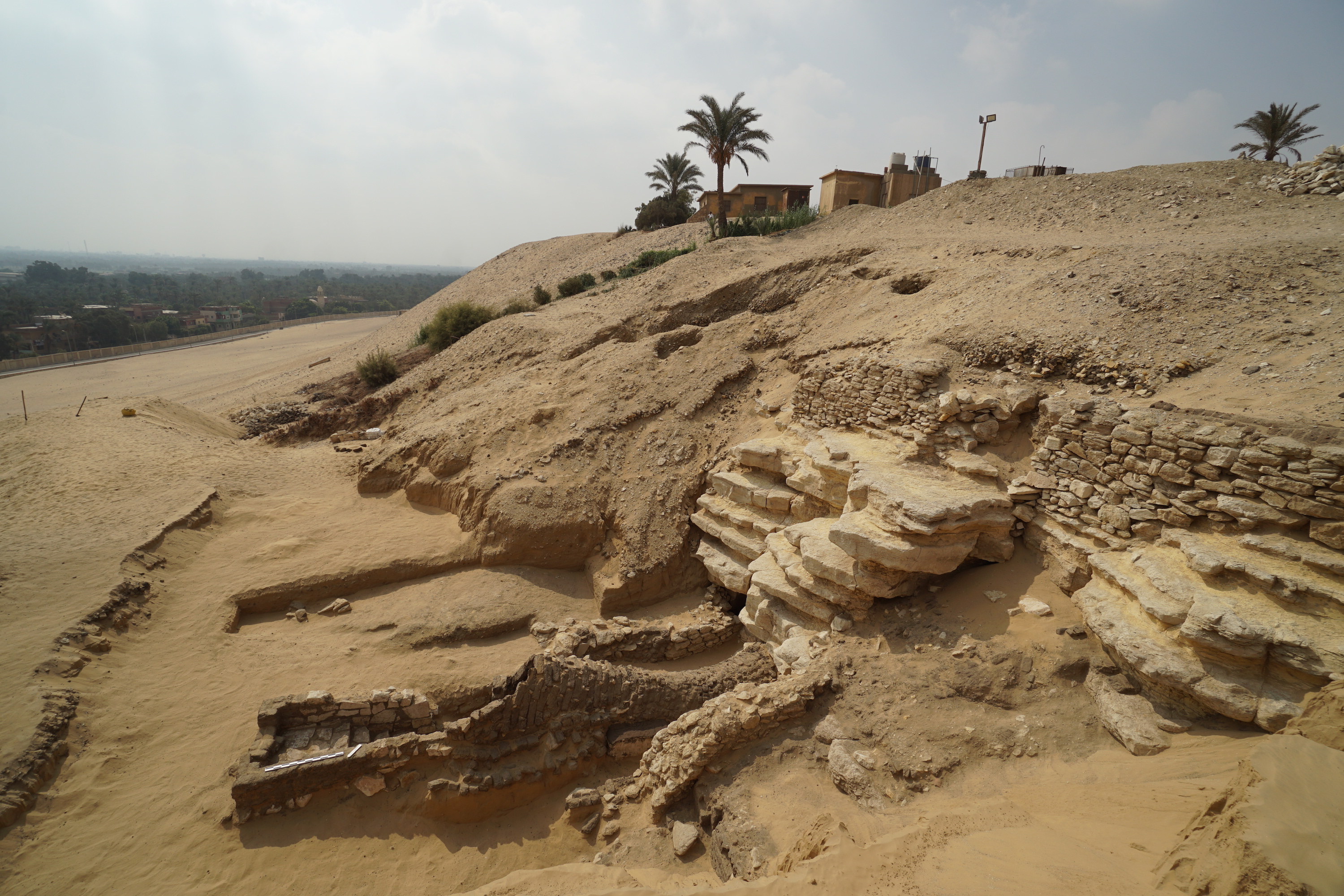
This exhibition is an international traveling exhibition, but in the latter half of the venue, you can also see a special exhibition original to Japan. It is a state-of-the-art excavation survey still being conducted at the Saqqara archaeological site in Egypt.
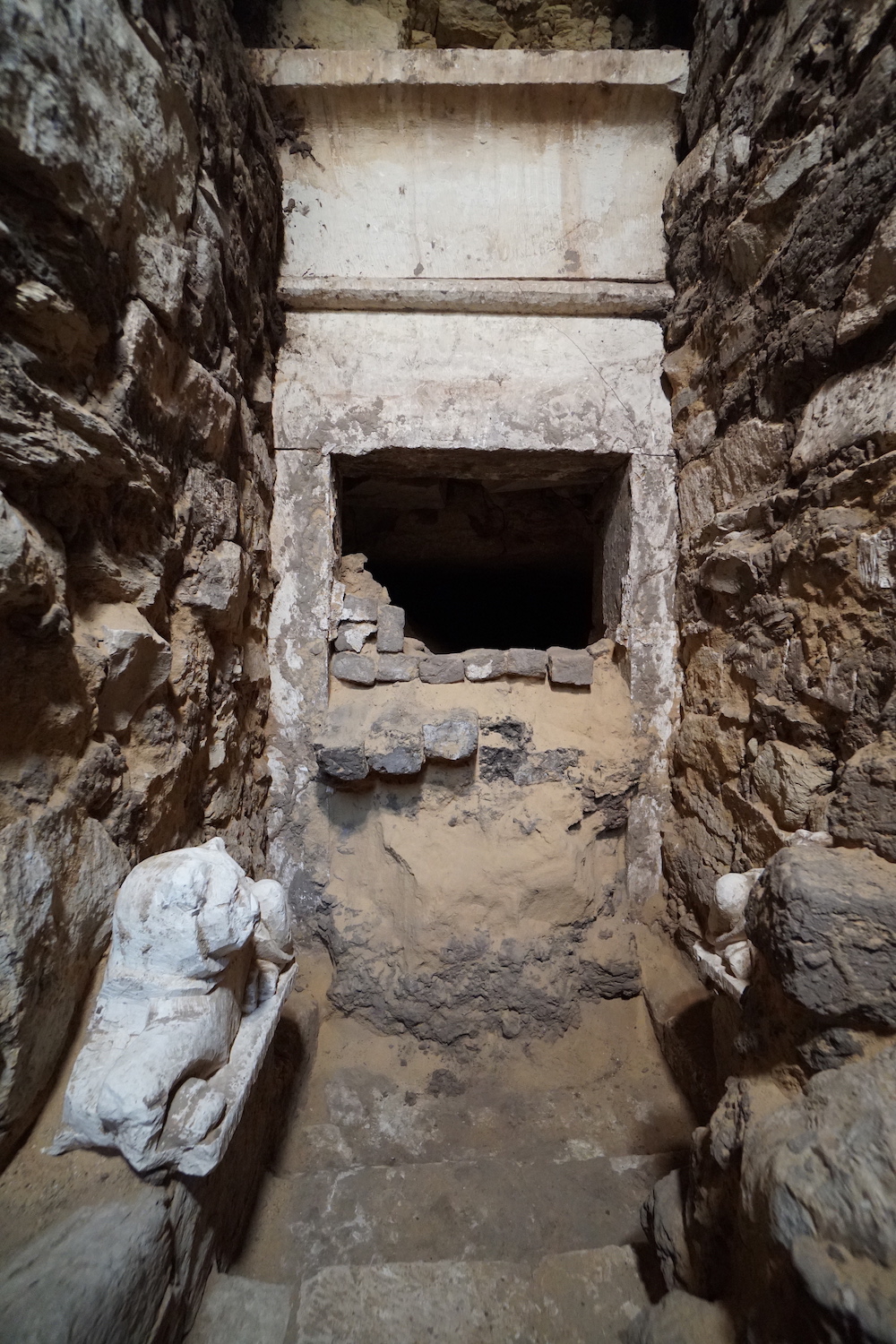
The actual size of the inside of the catacombs (underground mass grave) during the Roman rule, discovered in 2019 by the Japan-Egypt Joint North Saqqara Survey Team, headed by Professor Nozomi Kawai of Kanazawa University, who is the supervisor of this exhibition. Most of them will be introduced in models and videos. I couldn’t take a picture, but I was impressed by the attention to detail, such as the decayed atmosphere and the buried bones, that made me feel as if I was actually at the scene.
How were the six mummies that appeared in this exhibition unearthed so that we can appreciate them today? This exhibition should give you an idea of the big picture that wasn’t often introduced in the exhibition before.

If you want to hear the excitement and excavation romance that Mr. Nozomi Kawai felt and want to enhance the sense of reality, we recommend using the audio guide.
Let’s smell the mummy
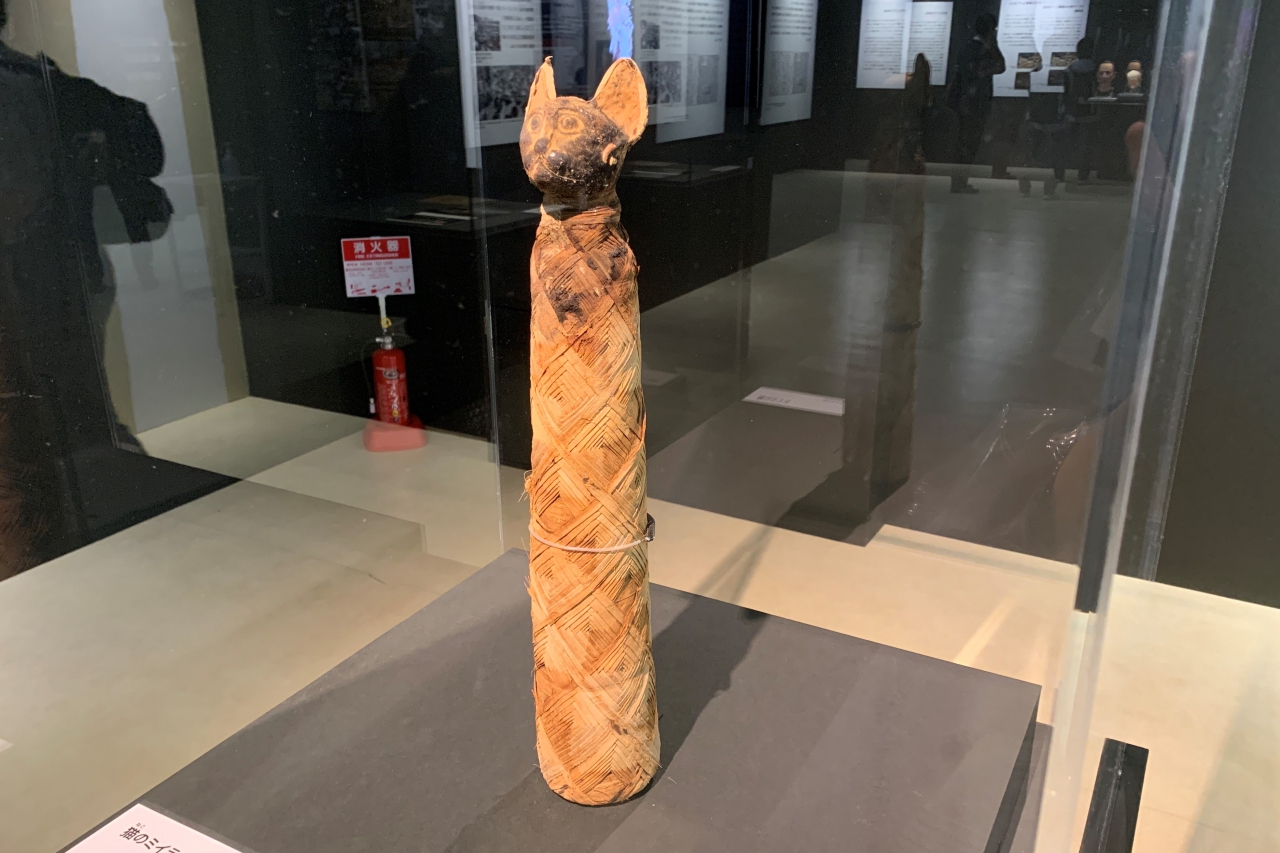
At the second venue, under the theme of “Ancient Egyptian Civilization and the Japanese,” we will introduce how the Japanese learned about the existence of the ancient Egyptian civilization and continued their research. Here, the “Cat Mummy” obtained in Egypt by Masauji Hachisuka, the 18th head of the Awa and Tokushima Domains, is unveiled for the first time.
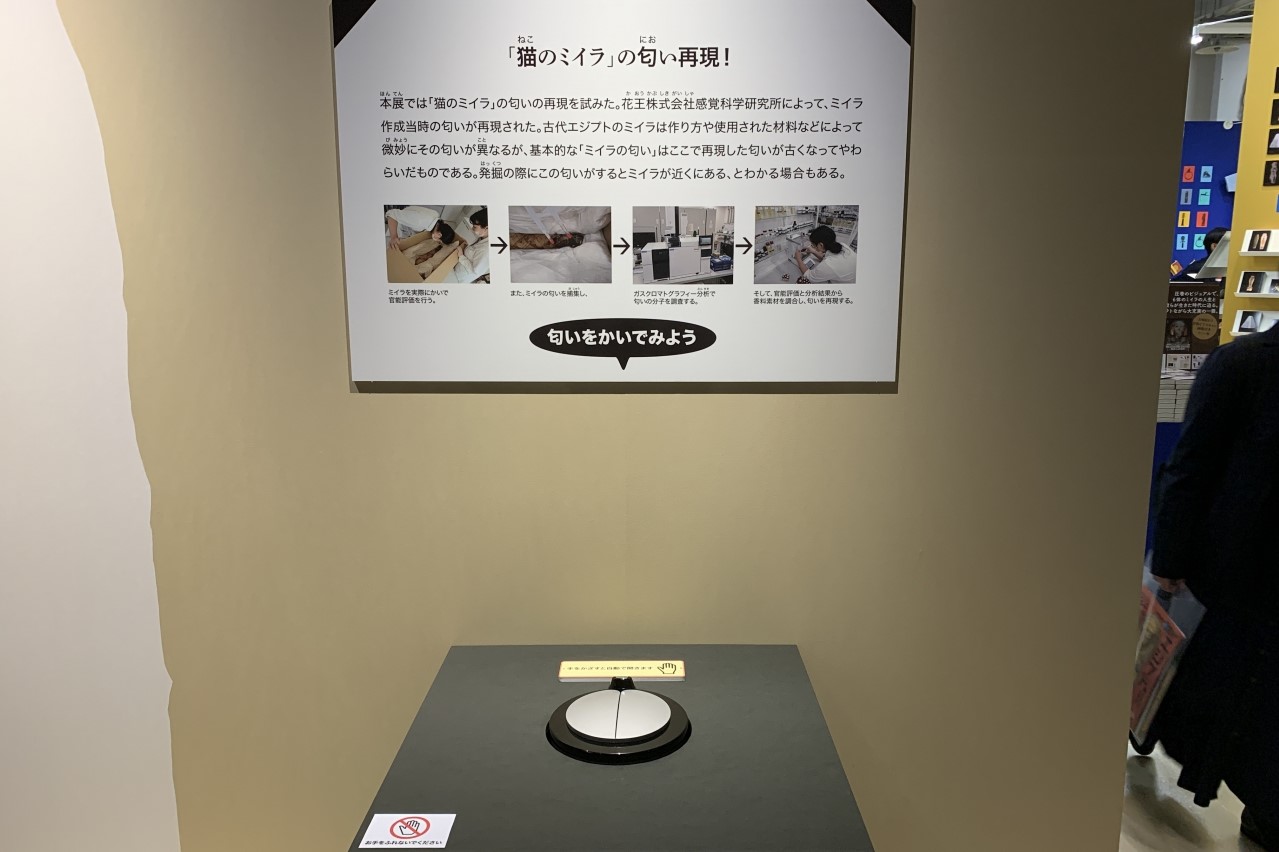
In connection with “Cat Mummy”, there is also a corner where you can smell the mummy at the time of making it, which was reproduced by Kao Corporation’s Sensory Science Research Institute! The chance to smell a mummy is unlikely for the average person, so it’s a valuable opportunity.
Special collaboration with “Kaiketsu Zorori”!

In addition, this exhibition attracts the attention of fans by collaborating with the reading series “Kaiketsu Zorori”, which is loved by a wide range of generations.
A quiz about the story of rescuing Zorori and others who have lost their way into the world of ancient Egypt and cannot return to the present day is posted on the official website. If you want to watch it with a small child, please try it by referring to the hints on the panel inside the venue. In addition, many “Kaiketsu Zorori” original goods were prepared at the special shop, so fans should not miss it.
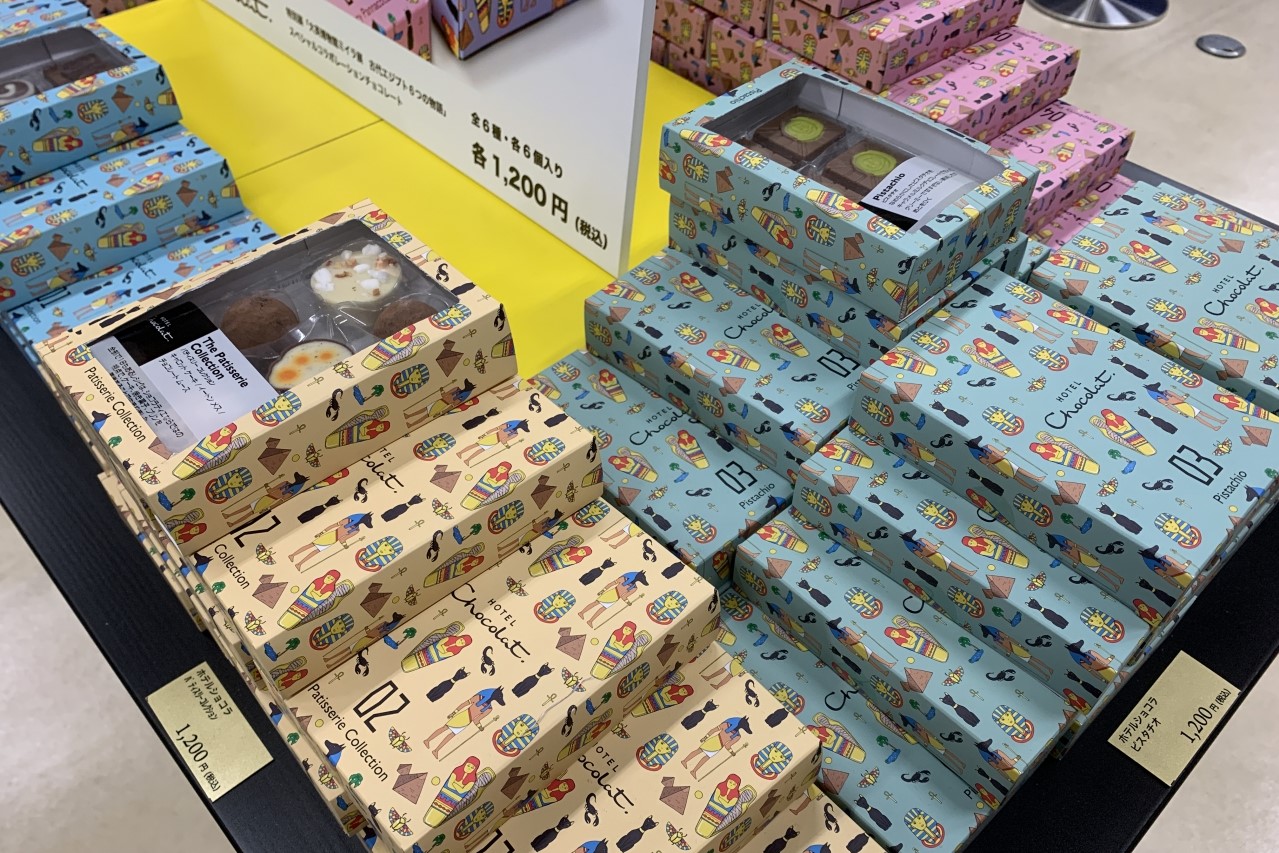
Outline of the special exhibition “British Museum Mummy Exhibition 6 Stories of Ancient Egypt”
| Session | October 14, 2021 (Thursday) -January 12, 2022 (Wednesday) * The session is subject to change. |
| venue | National Science Museum |
| Opening hours | 9:00 to 17:00 (Admission is 30 minutes before closing time) |
| closing day | Monday, December 28th (Tuesday) -January 1st (Saturday / holiday) * However, the museum is open on December 27th (Monday), January 3rd (Monday), and January 10th (Monday / holiday). |
| Admission fee | General / university students 2,100 yen Elementary / junior high / high school students 600 yen (tax included) * Reservation by date and time is required. * Free for preschoolers. Free for persons with a disability certificate and one caregiver. |
| Organizer | National Science Museum, British Museum, Asahi Shimbun |
| inquiry | 050–5541–8600 (Hello dial) |
| Exhibition official website | https://daiei-miira.exhibit.jp/ |

